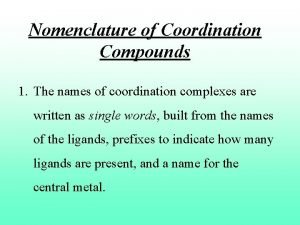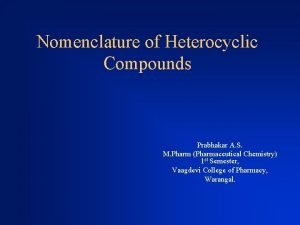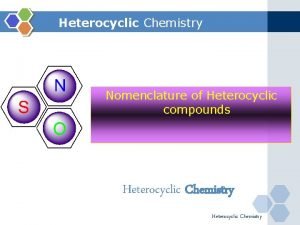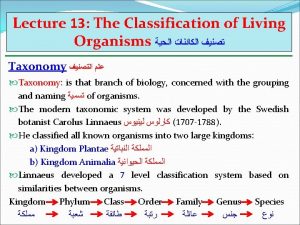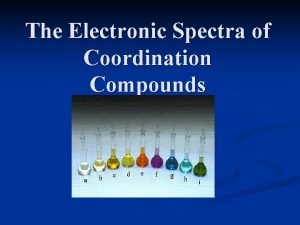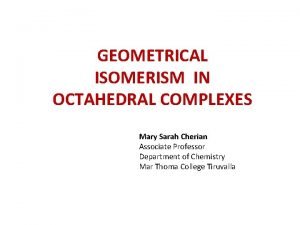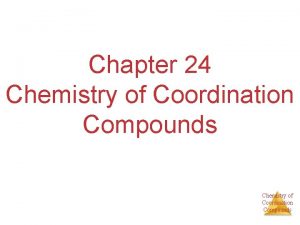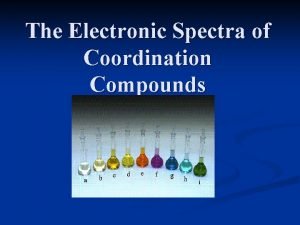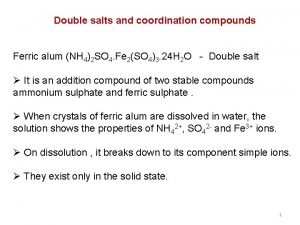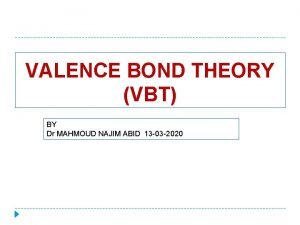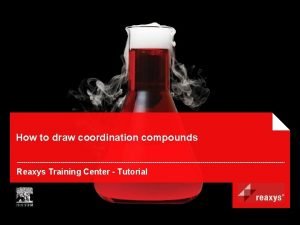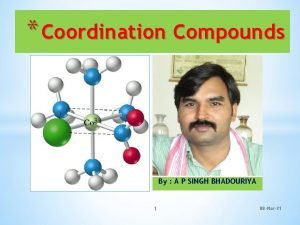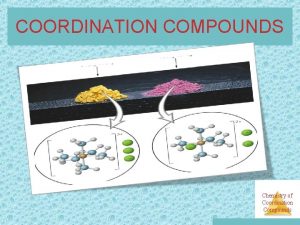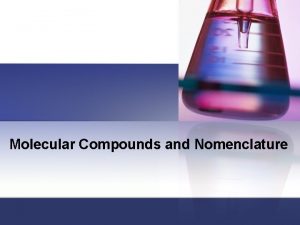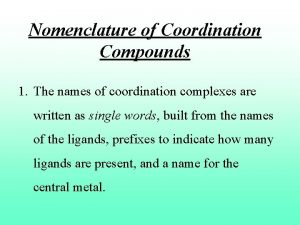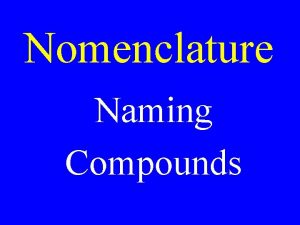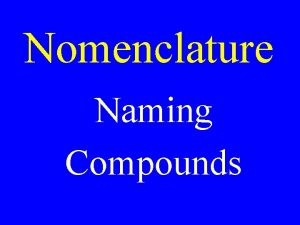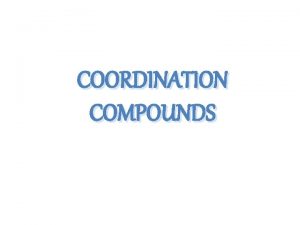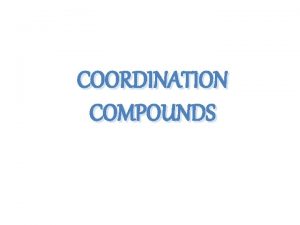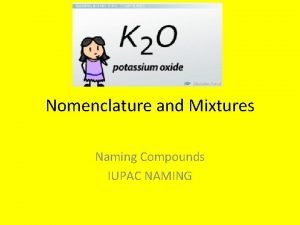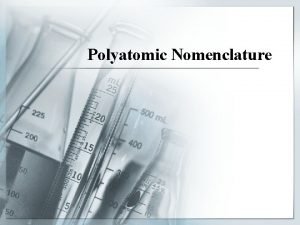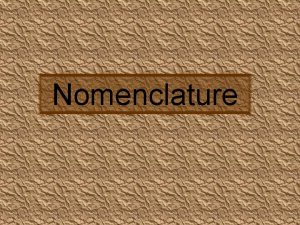Nomenclature of Coordination Compounds 1 The names of














- Slides: 14

Nomenclature of Coordination Compounds 1. The names of coordination complexes are written as single words, built from the names of the ligands, prefixes to indicate how many ligands are present, and a name for the central metal.

2. If the coordination complex is ionic, that consists of two (or more) ions, one of which is the nucleus of this complex: the positive ion is named first, followed (after a space) by the name of the negative ion, regardless of which is the complex ion.

3. When giving the name of the complex ion or molecule, the ligands are named first, followed by the name of the metal. 4. Coordinated groups (ligands) are listed in the following order: negative ligands, neutral ligands and then positive ligands.

5. Negative ligands end with the suffix –o, for example CN cyano, Cl chloro, NO 2 nitro, and OH hydroxo. If there are several negative ligands present, these are listed alphabetically.

Naming Coordination Compounds LIGAND Name of Ligand in Coord. Cpd. Bromide, Br. Bromo Chloride, Cl. Chloro Cyanide, CNCyano Hydorxide, OHHydroxo Oixde, O 2 Oxo Carbonate, CO 32 Carbanato Nitrite, NO 3 Nitro Oxolate, C 2 O 42 Oxolato Ammonia, NH 3 Ammine Carbon monoxide, CO Carbonyl Water, H 2 O Aquo Ethylenediamine(en) Ethylenediamine

6. Neutral ligands have no special ending, e. g. NH 3 ammine (not amine or amino), H 2 O aquo, CO carbonyl, NO nitrosyl, and hydrocarbons end in –yl, for example phenyl and methyl. If several neutral ligands are present, these are listed as follow: H 2 O then NH 3 then any others alphabetically.

7. Positive groups end in –ium, e. g. NH 2–NH 3+ hydrazinium. 8. Greek prefixes (di-, tri-, tetra-, penta-, hexa- ) are used to indicate the number of ligands of a given type (of the same type) attached to the central ion; if there is only one ligand, the prefix mono- is not used.

• • • Di (2) tri (3) tetra (4) Penta (5) Hexa (6) [Co(NH 3)4 Cl 2]+are tetraamminedichloro

9. When the name of the ligand includes a number, e. g. dipyridyl or ethylenediamine then the name of the ligand is placed in parentheses (brackets) and the prefixes bis-, tris-, and tetrakis- are used instead of di-, tri-, and tetra-. e. g. [Cu(en)2]2+ bis(ethylenediamine)

10. The oxidation state of the central metal atom is given by a Roman numeral enclosed in parentheses immediately following the name of the metal. [Cr(NH 3)4 Cl 2]+, which is called tetraamminedichlorochromium(Ⅲ) ion.

11. If the complex ion has a net negative charge, the ending –ate is added to the stem (end) of the name of the metal. But complex positive ions and neutral molecules have no special ending. K 4[Fe(CN)6] the anion [Fe(CN)6]4 - is called hexacyanoferrate(II) ion.

Metal in anion complex Aluminum Aluminate Chromium Chromate Cobaltate Copper Cuprate Gold Aurate Iron Ferrate Lead Plumbate Metal in anion complex Manganese Manganate Nickelate Silver Argentate Tin Stannate Tungsten Tungstate Zincate

12. If the complex contains two or more metal atoms, it is termed “polynuclear”. The ligands that link the two metal atoms are called “bridge groups” and are separated from the rest of the complex by hyphens and denoted by the prefix .

13. If any lattice components such as water or solvent of crystallization are present, these follow the name, and are preceded by the number of these groups in Arabic numerals.
 Coordination compound nomenclature
Coordination compound nomenclature Optical isomerism octahedral complexes
Optical isomerism octahedral complexes Nomenclature of binary ionic compounds
Nomenclature of binary ionic compounds What functional group is ch3
What functional group is ch3 Heterocyclic compounds nomenclature
Heterocyclic compounds nomenclature Hetrocycle
Hetrocycle Binomial nomenclature consists of two names *
Binomial nomenclature consists of two names * Electronic spectra of coordination compounds
Electronic spectra of coordination compounds Geometrical isomerism in coordination compounds
Geometrical isomerism in coordination compounds Werner coordination number
Werner coordination number Electronic spectra of coordination compounds
Electronic spectra of coordination compounds Ferric alum as a double salt
Ferric alum as a double salt Limitations of valence bond theory
Limitations of valence bond theory Drawing coordination compounds
Drawing coordination compounds Difference between double salt and complex compound
Difference between double salt and complex compound
